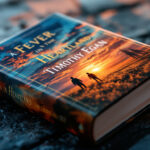Review of The Wright Brothers by D. McCullough – An Aviation History
Published in 2015, The Wright Brothers by David McCullough brings to life the incredible story of Wilbur and Orville Wright, the minds behind humanity’s first powered flight. Widely acclaimed for his engaging storytelling, McCullough skillfully captures the brothers’ dedication, ingenuity, and perseverance in the face of skepticism and setbacks. This book doesn’t just recount their achievements—it delves into the lives, struggles, and relentless curiosity that propelled them to revolutionize transportation forever. If you’re curious about the roots of modern aviation or simply admire stories of persistence, this biography is a must-read.
Overview of the Wright Brothers
When we think of human flight, the Wright brothers are often the first names that come to mind. Wilbur and Orville Wright didn’t just achieve powered flight; they laid the groundwork for modern aviation. This section delves into their early influences and the relentless innovation that defined their journey.
Early Life and Influences
Wilbur Wright, born in 1867, and Orville Wright, born in 1871, grew up in a supportive and intellectually curious household in Dayton, Ohio. Their father, Milton Wright, a bishop in the Church of the United Brethren, encouraged his children to question, explore, and learn. One of their earliest inspirations came from a simple toy—a small helicopter made of paper and bamboo, powered by a rubber band, gifted by their father. This seemingly ordinary toy sparked their fascination with flight and mechanical design.
The brothers did not follow conventional paths of higher education; instead, they cultivated self-taught skills and relentless curiosity. In 1892, they opened a bicycle repair and sales shop. Their work in bicycle manufacturing not only funded their aviation experiments but also honed mechanical skills crucial to building their first airplane. Working with bicycles taught them about balance, lightweight construction, and aerodynamics—principles they later applied to their flying machines.
Their ability to turn everyday experiences into stepping stones for groundbreaking invention is a testament to their innovative mindset. For more on their childhood and family dynamics, you can explore this biography of the Wright brothers.
Innovative Spirit and Perseverance
What set the Wright brothers apart wasn’t just their technical know-how but their unshakeable determination. Unlike others who abandoned the pursuit of flight due to repeated failures, Wilbur and Orville were methodical problem-solvers. They studied the failures of preceding inventors and worked diligently to overcome each challenge.
They faced widespread skepticism, especially during an era when many believed human flight was impossible. Yet, they never let doubt deter them. The brothers’ development of the three-axis flight control system was revolutionary. This innovation allowed pilots to steer and stabilize an aircraft, resolving problems that had baffled prior aviation experiments. You can learn more about their contributions to aviation design in this insight into their innovative legacy.
Their commitment to testing was another key to their success. They conducted hundreds of glider flights and built their own wind tunnel to refine their aircraft designs. Each setback was treated as a lesson, and each experiment brought them closer to controlled, sustained flight. On December 17, 1903, in Kitty Hawk, North Carolina, the Wright Flyer made history as the first successful powered flight.
The Wright brothers’ story is a powerful reminder of what can be achieved through a mix of creativity, resilience, and grit. They weren’t just inventors; they were visionaries who reshaped our understanding of transportation forever.
The Wright Brothers’ Journey to Flight
The Wright brothers’ story is one of vision, experimentation, and resilience. Their road to becoming the pioneers of aviation was neither smooth nor straightforward but paved with incremental progress, ingenious problem-solving, and dogged determination. This section explores key phases of their journey, from kite and glider experiments to the historic first powered flight, along with the technical innovations and challenges they faced.
Kite and Glider Experiments
The Wright brothers’ aviation journey started small—literally. In 1899, Wilbur built a kite based on his theories of wing-warping control. This kite wasn’t just child’s play; it was, in fact, a scaled-down model for testing an innovative control system. By manipulating the kite’s cords, the brothers began exploring how to steer a craft mid-flight. You can learn more about their early kite experiments here.
From kites, they transitioned to building manned gliders, conducting their first tests in 1900 at Kill Devil Hills near Kitty Hawk, North Carolina. The gliders allowed them to experiment with lift, drag, and control mechanisms. Each iteration improved their designs. Their persistence paid off in 1902 when they successfully flew a glider with three-axis control—a system still fundamental to aviation today. Interested in their glider developments? Check out this insightful resource.
Breakthrough at Kitty Hawk
The culmination of years of trial and error came on December 17, 1903. On the windy sands of Kitty Hawk, the brothers achieved the first powered flight in human history. The aircraft, aptly named the Wright Flyer, was piloted by Orville during its initial 12-second flight, which covered 120 feet. This groundbreaking achievement marked the dawn of modern aviation. Detailed accounts of this historic day can be found through the National Park Service.
What’s remarkable is their understated approach. They didn’t have massive crowds or public celebrations; just a handful of witnesses and a determination to keep refining their design. That day, they completed four flights, the longest lasting 59 seconds and covering 852 feet. The event reshaped transportation and sparked the age of human flight.
Technical Innovations
The Wright brothers’ success didn’t come from untested theories or blind luck. It was their engineering prowess and relentless experiments that set them apart. In 1901, they built one of the first wind tunnels to precisely measure aerodynamic forces on various wing shapes. This step offered data-driven insights that refined their designs. Learn more about their wind tunnel experiments here.
Other inventors of the time relied on guesswork or flawed assumptions, but the Wrights’ systematic approach was revolutionary. They tested hundreds of wing shapes and control configurations, achieving breakthroughs that others could not. Their three-axis control system remains a cornerstone of modern aircraft, allowing pilots to manage pitch, roll, and yaw.
Support and Challenges
The Wright brothers’ journey wasn’t all clear skies. While their breakthroughs are celebrated today, they initially faced skepticism and significant challenges. Many doubted the feasibility of powered flight, and their early achievements garnered little attention outside select circles. Even the Smithsonian Institution, a prominent scientific body, was slow to recognize their accomplishment due to its own controversies in aviation history. If you’re curious, this article highlights the tensions between the Wrights and the Smithsonian.
They also had financial hurdles and limited institutional support during their experimental phases. Unlike today’s inventors who might secure grants or venture capital, the brothers largely funded their work with proceeds from their bicycle shop in Dayton, Ohio. These challenges didn’t deter them but instead fueled their determination to prove skeptics wrong.
Public recognition grew slowly but surely after their further exhibitions and demonstrations in Europe. However, the brothers’ resilience in the face of doubt not only proved critics wrong but also created a legacy that continues to inspire.
The Wright Brothers in Context
The invention of powered flight by the Wright brothers was a turning point in human history. Yet, their groundbreaking achievement didn’t immediately capture the attention or imagination of the world. From limited recognition in the United States to reshaping how we understand transportation, communication, and technology, their impact unfolded differently based on societal and historical contexts.
Initial Reception and Media Coverage
When the Wright brothers achieved the first powered flight in 1903, their success was met with surprising indifference in the United States. Local newspapers, such as those in Dayton, Ohio, largely ignored or dismissed the event. Many editors labeled their claims as either exaggerated or outright impossible. The modern phrase “If it bleeds, it leads” probably applied here—early aviation lacked the sensational appeal that drove headlines. In fact, it wasn’t until the Wrights demonstrated their flying machine in Europe that international acclaim began to cement their place in history.
France, a nation already captivated by scientific and technological progress, embraced the Wright brothers with enthusiasm. Demonstrations of their flight abilities in 1908 at Le Mans generated widespread media coverage. The French press, long interested in aeronautical experiments, enthusiastically declared the Wrights as pioneers of a new era. This warm reception abroad eventually influenced greater recognition back home. For more details on the initial media response, this article sheds light: When the Wright Brothers shocked the world, the media flubbed it.
The Wrights’ initial obscurity demonstrates how societal attitudes and media priorities can shape public awareness of innovation. In time, however, their achievements could not be ignored, especially after commercial and military applications of flight began to emerge.
The Transformation of Society
The Wright brothers’ invention transcended its era, ultimately reshaping modern life in countless ways. The airplane not only revolutionized transportation but also transformed communication and our relationship with technology.
- Transportation: Airplanes drastically shortened travel times, connecting distant parts of the globe. What once took weeks by ship or rail could now be accomplished in mere hours, paving the way for business travel, tourism, and global trade. In fact, airplanes are the backbone of modern logistics networks, ensuring rapid delivery of goods worldwide. Learn more about how airplanes changed transportation at Taking flight: A history.
- Communication: Before the era of flight, face-to-face communication across continents was an unreachable dream for most. Airplanes made it possible to physically bridge gaps between nations, fostering cultural exchange and collaboration. Even in the digital age, flights remain an essential tool for diplomacy and global commerce.
- A New Era of Technology: The innovations the Wright brothers introduced—such as aerodynamic control and lightweight construction—set the stage for technological advancements in countless industries. Their work demonstrated that methodical experimentation and data-driven engineering could overcome challenges once deemed impossible.
The influence of flight also inspired advancements in warfare, space exploration, and even everyday tools like GPS technology. For a deeper dive into aviation’s impact on societal and technological progress, review this resource: 5 ways the aviation industry has impacted the modern world.
The airplane started as an audacious experiment but evolved into a cornerstone of modern life. It redefined what humans could achieve, pushing boundaries and transforming how we see the world and connect with one another.
David McCullough’s Storytelling Approach
David McCullough, a renowned historian and author, had a rare talent for making history come alive. Through meticulously researched narratives and an engaging writing style, he transformed historical figures and events into stories that resonate with readers. His book The Wright Brothers is no different, offering a masterclass in storytelling. Let’s break down two key elements of his narrative approach that make this book a standout.
Use of Primary Sources
McCullough’s reliance on primary sources is a hallmark of his work. In The Wright Brothers, he draws extensively from original letters, diaries, newspaper articles, and technical documents. This approach lends authenticity to his storytelling, building trust with the reader and ensuring that every detail is rooted in fact.
By exploring the archived correspondence between Wilbur and Orville Wright, he gives readers a window into their thoughts, frustrations, and triumphs. For example, Wilbur’s letters reveal his intellectual rigor and relentless desire to solve the mysteries of flight. Similarly, McCullough incorporates period newspaper accounts, which capture public skepticism and excitement about the Wright brothers’ endeavors. These reports anchor the story in its historical context, offering a glimpse into how their achievements were perceived at the time.
What’s striking is his ability to weave technical documents into an accessible narrative. McCullough simplifies the complexities of early aviation without oversimplifying, making intricate engineering concepts understandable to readers. His skill in balancing detailed research with readability sets him apart as a historian. For a deeper look at how McCullough mastered the art of storytelling by tapping into original sources, you can explore this article on his work.
Engaging and Accessible Writing
One of McCullough’s greatest strengths lies in his writing style. He has an uncanny ability to turn dense historical material into vivid, compelling stories. His prose is clear and conversational, making even technical or complex subjects feel approachable. This ability to communicate history in a way that anyone can enjoy is part of what makes The Wright Brothers such a rewarding read.
McCullough doesn’t overwhelm readers with jargon or dry facts. Instead, he uses relatable anecdotes and vivid imagery to draw readers in. For instance, when describing the Wright brothers’ experiments at Kitty Hawk, he paints a picture of the harsh winds, shifting sands, and the brothers’ sheer determination. You can almost feel the grit of the environment and the weight of their monumental task.
What makes his writing truly engaging is its emotional depth. McCullough captures the human side of history—the doubts, the sacrifices, and the personal stakes involved. In The Wright Brothers, this human element is evident in the portrayal of their family bond and the isolation they often felt while pursuing what many deemed impossible. For insight into McCullough’s impactful writing methods, you might find this interview particularly enlightening.
By combining meticulous research with a narrative style that feels intimate and accessible, McCullough creates a reading experience that’s both educational and deeply satisfying. His work reminds us that history isn’t just a series of dates and events—it’s a collection of stories about people, their challenges, and their triumphs.
What Sets the Book Apart
David McCullough’s The Wright Brothers stands out among biographies by presenting a deeply human story of two brothers who defied the odds. McCullough goes beyond the technicalities of flight and captivates readers with a portrait of determination, ingenuity, and unbreakable familial bonds.
Unique Perspective
Unlike many historical accounts that focus on the invention of flight alone, McCullough shines a spotlight on the human side of Wilbur and Orville Wright. Through vivid storytelling, he offers unique insights into their personalities, work ethic, and relationship dynamics, painting a more complete picture of their lives. This approach humanizes the Wright brothers, making their achievements even more remarkable.
McCullough highlights how the brothers remained dedicated despite their modest means and lack of formal education, a narrative rarely explored in other tellings. The book also emphasizes their family’s unwavering support, especially that of their sister Katharine, who played an instrumental role in their journey. This focus on the personal rather than just the mechanical adds a fresh dimension to their story. For a deeper look into how McCullough captures these aspects, see this review on The Wright Brothers.
McCullough doesn’t just recount their success; he immerses readers in their world. From their humble bicycle shop in Dayton, Ohio, to the sandy dunes of Kitty Hawk, he vividly illustrates the settings that shaped their vision. The narrative brings out the sheer grit and determination it took to achieve what was once thought impossible.
Historical Accuracy and Attention to Detail
McCullough is known for his meticulous research and dedication to historical accuracy, and this book is no exception. Drawing from an array of primary sources—letters, diaries, and newspaper clippings—he crafts a narrative that feels both authentic and trustworthy. His use of these materials not only underpins the book’s credibility but also enriches the storytelling with details that other authors might overlook.
The attention to detail makes The Wright Brothers a treasure trove for history enthusiasts. McCullough delves into every facet of their journey, including lesser-known struggles and triumphs. For instance, the book sheds light on their innovative use of a homemade wind tunnel, an anecdote that underscores their resourcefulness and technical brilliance. Discover more about McCullough’s dedication to historical precision in this interview about his writing process.
By coupling rigorous research with his engaging writing style, McCullough ensures that readers feel both informed and entertained. His storytelling transforms what could have been a dry recounting of events into a lively and inspiring tale. The authenticity and depth of the narrative make this book a valuable resource for anyone captivated by history or innovation.
Lessons from the Wright Brothers
The Wright brothers’ journey to achieving the first powered flight is more than an aviation milestone; it’s a masterclass in perseverance, teamwork, and innovation. Their story isn’t just about building an airplane but about triumphing over obstacles and collaborating in a way that changed history forever. Let’s explore the most valuable lessons we can draw from their experience.
The Power of Perseverance
Wilbur and Orville Wright knew failure intimately. For every small victory they achieved, there were countless setbacks, errors, and outright disasters. Yet, through it all, they refused to give up on their dream of human flight. They faced the skepticism of their peers, the limitations of technology at the time, and the physical risks of testing their prototypes. So how did they do it?
- Learning from Setbacks: Each failed glider test wasn’t the end of the road—it was data. Instead of despairing, they analyzed each failure meticulously to improve their designs. Over time, this methodical approach allowed them to refine their understanding of aerodynamics and mechanics. You can find a deeper dive into their perseverance here.
- Relentless Curiosity: When existing scientific principles failed to explain their problems, the brothers didn’t stop. They built their own wind tunnel—a groundbreaking invention at the time—to generate data. This level of commitment and resourcefulness teaches us that obstacles are often opportunities in disguise. Check out another example of their determination here.
- Staying Focused Amidst Skepticism: Many considered their dream impossible, as human flight was widely dismissed at the time. The Wright brothers proved that unwavering focus and persistence are critical to achieving what others might consider inconceivable.
Their story reminds us that resilience is not just about enduring hardship but using it as a ladder to greater achievements. Whether you’re pursuing personal goals or professional ambitions, the Wrights prove that persistence always pays off.
Collaboration and Teamwork
The incredible partnership between Wilbur and Orville Wright was central to their success. While many inventors work in isolation, the Wright brothers leaned on each other’s strengths and created a model of collaboration that remains inspiring today.
- Complementary Strengths: Wilbur was known for his analytical skills and big-picture thinking, while Orville focused on the intricate details of engineering and testing. Their ability to harmonize their different perspectives allowed them to problem-solve effectively and efficiently.
- Shared Vision: Despite their differences, the brothers shared a unified vision of conquering flight. This mutual drive eliminated the ego and competition that could have derailed their efforts. Instead of competing, they collaborated—a lesson critical to any successful team or partnership. For a unique perspective on how their teamwork set them apart, read this take.
- Accountability Through Family Bonds: Family played an important role in their journey. Their sister, Katharine, managed many logistical and emotional challenges, ensuring that disagreements or setbacks didn’t escalate. The way the Wright family lifted each other up is a reminder that no great achievement is ever truly a solo effort. Explore the impact of their collaboration further here.
In today’s world, where individual achievement often gets celebrated, the Wright brothers illustrate the value of partnership. Whether you’re part of a professional team, a close-knit family, or a creative collaboration, their story shows how pooling talents and supporting one another can lead to groundbreaking success.
Ultimately, it’s clear that the Wright brothers’ triumph was as much about their character and relationships as it was about their inventions. They proved that success comes from not just what you do, but how and with whom you do it.
Final Thoughts on ‘The Wright Brothers’
David McCullough’s The Wright Brothers offers more than a biography; it’s a reflection on innovation, persistence, and the power of family. While the book applauds Wilbur and Orville’s engineering genius, it also reveals the human qualities that made their success possible. McCullough doesn’t just explain what they achieved but shows you the who, how, and why.
Strengths of the Book
McCullough brings history to life with his clear, engaging writing style. Instead of overwhelming readers with technical jargon, he captures the Wright brothers’ humanity—sharing their highs, lows, and everything in between. His use of primary sources like personal letters and diaries deepens the narrative, making you feel as though you’re stepping into their workshop. For example, he highlights Wilbur’s intellectual rigor and Orville’s hands-on approach with vivid anecdotes.
Another strength is McCullough’s ability to break down complex engineering challenges into bite-sized explanations. Whether discussing kite experiments or wind tunnels, he makes these details relatable, even for those who aren’t mechanically inclined. Curious to read more about how McCullough achieved this balance? Check out this book review.
Finally, the pacing is superb. While some historical biographies drag under heaps of data, McCullough keeps the story moving. Each chapter builds on the last, guiding you effortlessly from the brothers’ childhood to their triumph at Kitty Hawk and beyond. For more insights into what makes this book stand out, visit this detailed review.
Who Will Love This Book?
This book is a gem for anyone who loves stories of ingenuity, perseverance, or history. If you’re fascinated by humanity’s ability to conquer the impossible, this read is for you. It’s also perfect for readers new to historical biographies. The narrative is so approachable it feels less like learning history and more like experiencing it.
Whether you’re a seasoned history enthusiast or someone dipping their toes into the genre, The Wright Brothers strikes a balance between depth and accessibility. McCullough’s storytelling serves as an ideal gateway to explore more works that connect the past with the present. You can find another evaluation of this book’s broad appeal here.
Conclusion
David McCullough’s The Wright Brothers is a rich, inspirational portrayal of two men whose passion and persistence changed the course of history. It humanizes Wilbur and Orville, showing not just their technical brilliance but their grit, creativity, and enduring family bonds. The book reminds readers that great achievements often come from humble beginnings and relentless effort.
If you’re someone who loves stories of innovation, determination, or simply enjoys a well-told history, this book is a must-read. It’s a celebration of ambition and the power of believing in the impossible. What lesson from the Wright brothers’ story resonates most with you? Let us know in the comments or share your thoughts with other readers.







